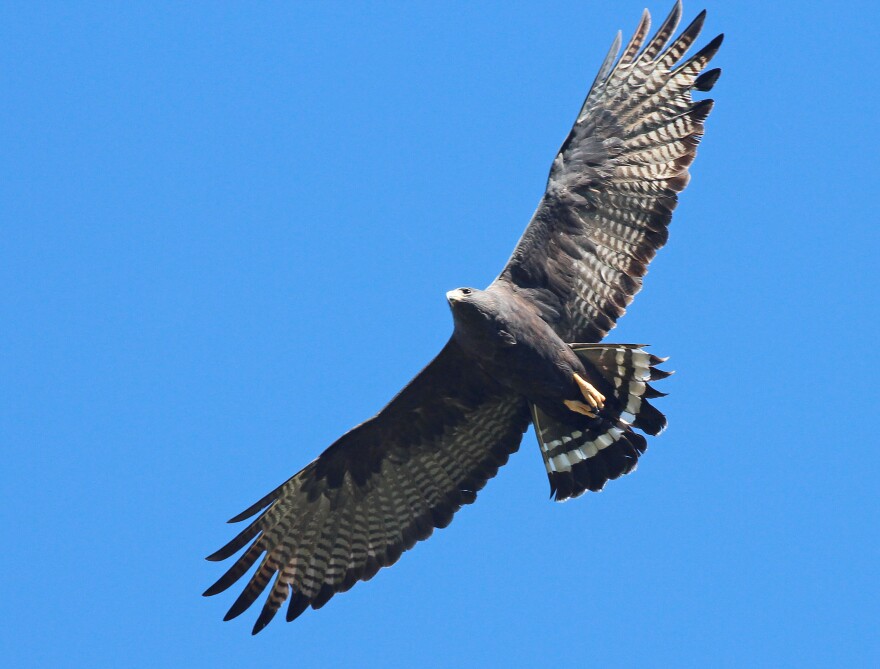Alamito Creek, Limpia Creek, Terlingua Creek, Terneros Creek – these Far West Texas waterways are mostly dry today. But before modern human impacts, they were perennial streams, lined with cottonwoods and willows. Restoring these streams is a top priority for Big Bend-area conservation groups.
Flowing water, of course, benefits many creatures – from fish and mussels to reptiles and mammals. But these “riparian zones” are especially critical for one commanding group of animals: raptors.
Dr. Clint Boal is a wildlife biologist with the U.S. Geological Survey and Texas Tech University.
“Pretty much everybody working in wildlife had some kind of a ‘gateway animal,’” Boal said. “Growing up, I had that fascination with birds of prey. Right now I have projects going on coyotes and foxes and kangaroo rats. But I've always had a real core of what I do focused on birds of prey.”
In 2017, Boal began studying raptors along creeks in Brewster and Presidio counties – with a particular focus on zone-tailed hawks.
Once known as “white-spotted buzzards,” zone-tailed hawks have 4-foot wingspans, which in profile resemble a turkey vulture’s. Three distinctive white bands mark their otherwise black tails.
Big Bend is the northern limit of their summer range, and before Boal’s study, they were known to nest only in cliffs along the Rio Grande. But Boal’s team captured zone-taileds along creeks here, and outfitted them with GPS devices.
The hawks, Boal learned, were wintering in the tropics – the Yucatan, Guatemala, Panama. But each summer, they returned to nest in the same creek-side cottonwoods.
And they had company. In these isolated cottonwood forests amidst the desert, Boal found a host of raptors nesting in close proximity.
“I have areas where within one kilometer you'll have a zone-tailed nest, a gray hawk nest, and a Cooper’s hawk nest,” Boal said, “and, probably if I looked hard enough, American kestrels in there somewhere as well.”
That fiercely territorial predators would raise young in such close quarters seems counterintuitive. But Boal and his colleagues saw a parallel with seabirds, like the common murre.
“They're oceanic,” Boal said of the seabirds. “They have to nest someplace, and so you get these rocky islands, these haystack islands in the ocean, and they'll nest all over those. They have a nest and they defend right around that, but right next to it's another nest, because that's all they've got. And that's all they really need.”
The diverse raptors have diverse diets: gray hawks specialize in lizards and snakes, zone-tailed hawks in grasshoppers and small mammals, and Cooper’s hawks in other birds. And the Big Bend’s deserts and grasslands offer bountiful prey.
With no competition for food, the raptors are apparently willing to tolerate one another’s company in the cottonwoods, which provide the nesting sites they all need.
“It’s like, ‘As long as he’s not too close, I'm not going to get in a fighting match with him,’” Boal said, “‘because it's not worth my time. We're not really hunting this grove of trees.’”
West Texas’ wooded mountains are known as “sky islands,” and we’re accustomed to thinking of them as places of special importance. But Boal’s findings show that riparian woodlands are islands of another kind. Most were lost in the first flush of white settlement – for timber in construction, and for mining operations. Preserving and restoring these forests is critical for West Texas wildlife, Boal said.
“It's really those mature trees that are a limited resource in the Trans-Pecos,” he said. “And so what's left is really valuable, and it is not valuable just for raptors. It's valuable for a whole cohort of avian, reptilian and mammalian species. They’re just really biologically rich areas.”
This story was made possible by generous donations from supporters like you. Please consider showing your support with a contribution today.



